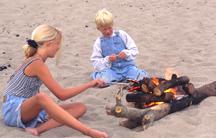|
Imagine yourself at a
picnic in a park. It is a beautiful day, and everything is just
great! You lay out your food, build a fire, and start roasting your
hot dogs. Then, suddenly, the wind starts blowing, the sky gets
cloudy, lightning flashes, thunder rolls, and rain starts pouring
down. You, your food, and your fire, all start to get wet. What
are you going to do?

Well, you have some
choices:
You could do nothing,
in which case, your food will get soaked, your fire will go
out, and you will get cold and wet and probably hungry. You
might even be struck by lightning!
You could put on
a big raincoat or put up a tarp to keep yourself, your food,
and your fire dry while you finish your picnic. (Of course,
you will still have to keep an eye on that pesky lightning.)
You could pick up
your stuff, go under a park shelter, and use the gas burners
to cook your food and finish your picnic.
You
could just go home and have an indoor picnic.
Yourself by
putting on a raincoat,
Your behavior
by using a gas fire under a shelter rather than a wood fire
out in the open, or
Your location
by going home,
you will be changing
or adapting to the changing weather so that you can continue
to enjoy your picnic.
On the other hand,
if you choose to do nothing to adapt to the changing conditions,
you will probably make yourself miserable, prevent yourself from
finishing your picnic, and you might even make yourself extinct!

When you started your
picnic, you had the right clothes and equipment for a sunny day
at the park. You were "fitted" or "adapted" to the environment
as it then existed. Similarly, plants and animals are adapted
to the environments in which they live. Their individual adaptations
permit them to get the food, water, and shelter they need to live.
For example, sharks have fins, streamlined bodies, and sharp teeth
that enable them to swim quickly and catch food in the ocean.
Trees have leaves to catch sunlight and roots to collect water
and nutrients from soil on land. Sharks cannot live on land and
trees cannot live in the ocean because they are not adapted to
those environments. Photos © 2000-www.arttoday.com
But environments
change. Just as your picnic environment changed when the cloudburst
came, environments around the world change over time. And as environments
change, the plants and animals living in them must change and
adapt to the new conditions. They must change the shape and function
of their bodies (physical adaptation),
or they must change their behavior (behavioral adaptation), or
they must move to a different place that has the environment they
need. Otherwise, they too become uncomfortable and possibly extinct!
Next
|











